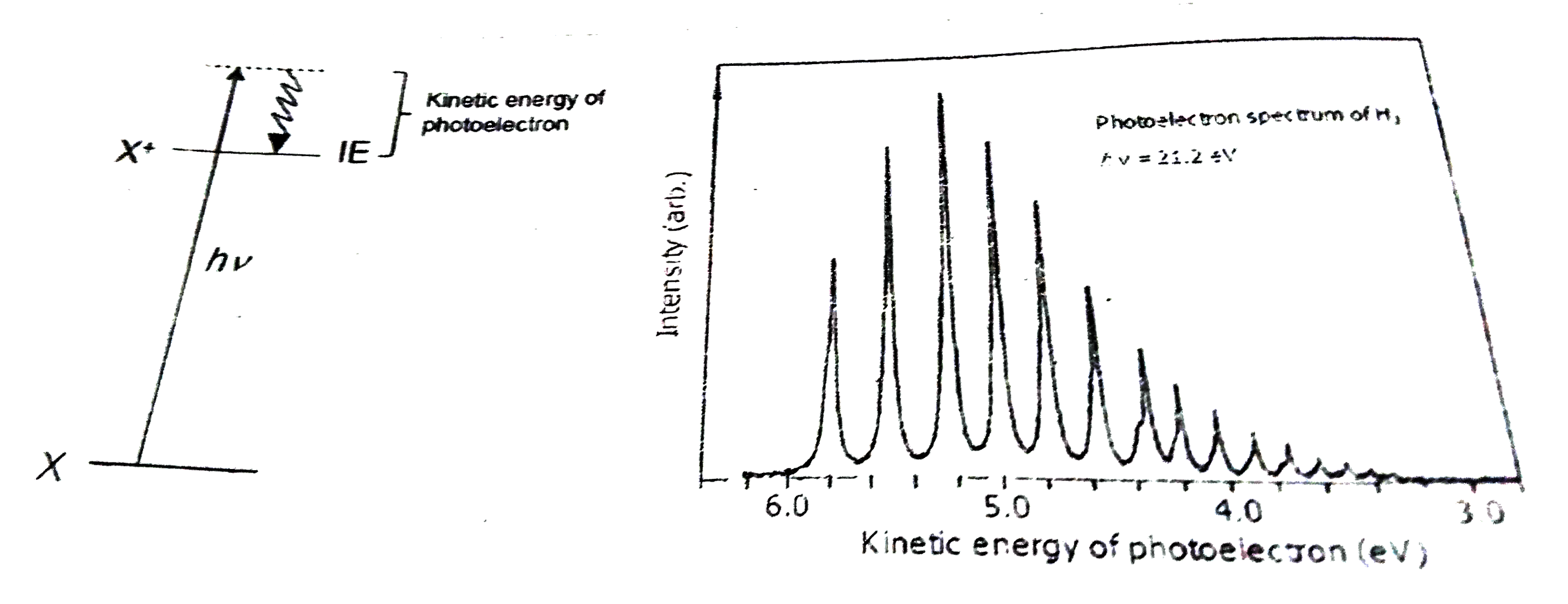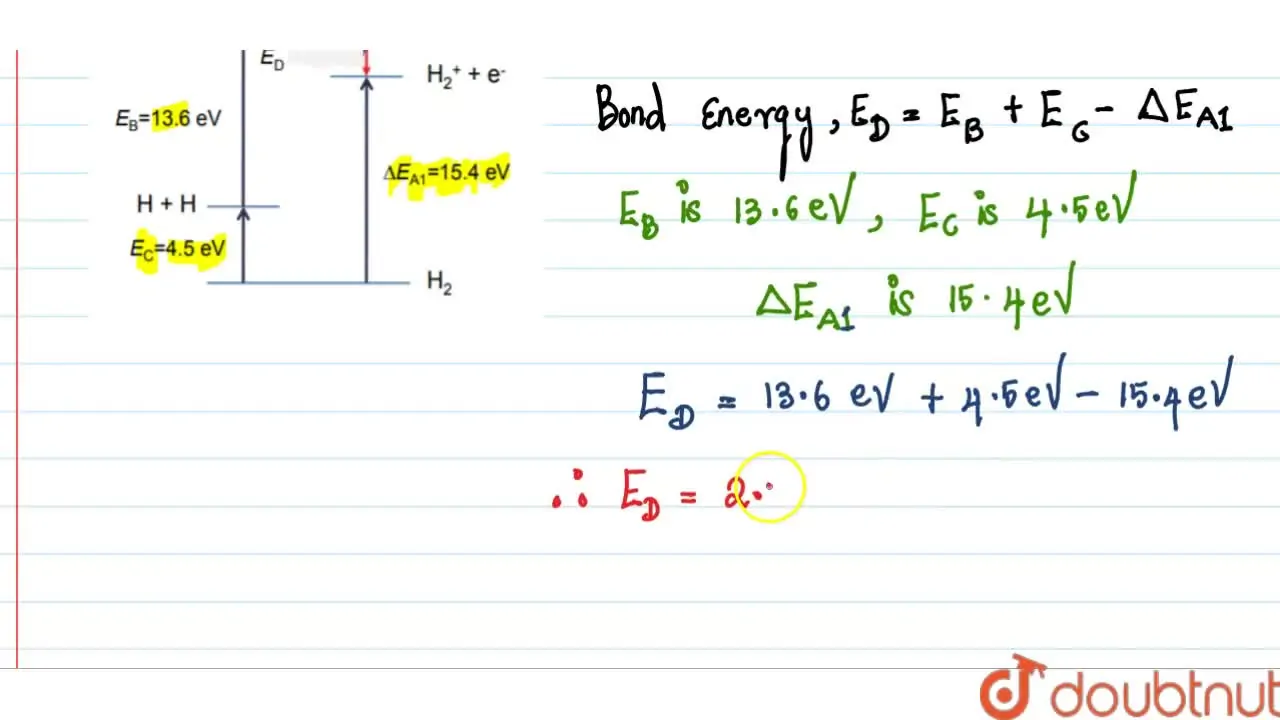When an atom X absorbs radiation with a photon energy than the ionization energy of the atom, the atom is ionized to generate an ion and the electron (called a photoelectron) is ejected at the same time. In this event, the energy is conserved as shown in Figure , that is,
Photon energy (h)=ionization energy (IE) of kinetic energy of photoelectron.
When a molecule, for example, , absorbs short-wavelength light, the photoelectron is ejected and an , ion with a variety of vibrational states is produced. A photoelectron spectrum is a plot of the number of photoelectrons as a function of the kinetic energy of the photoelectrons. Figure-2 shows a typical photoelectron spectrum when in the lowest vibrational level is irradiated by monochromatic light of . No photoelectrons are detected above . (eV is a unit of energy and is equal to )

Figure 1 Schematic diagram of photoelectron spectroscopy.
Figure 2 Photoelectron spectrum of . The energy of the incident light is
Considering an energy cycle, the bond energy of to the first decimal place. If you were unable to determine the values for and , then use and for and , respectively.
The correct Answer is:From Fig. below
Step by step video & image solution for When an atom X absorbs radiation with a photon energy than the ionization energy of the atom, the atom is ionized to generate an ion X^(+) and the electron (called a photoelectron) is ejected at the same time. In this event, the energy is conserved as shown in Figure 1, that is, Photon energy (h)=ionization energy (IE) of X+ kinetic energy of photoelectron. When a molecule, for example, H_(2), absorbs short-wavelength light, the photoelectron is ejected and an H_(2), ion with a variety of vibrational states is produced. A photoelectron spectrum is a plot of the number of photoelectrons as a function of the kinetic energy of the photoelectrons. Figure-2 shows a typical photoelectron spectrum when H_(2) in the lowest vibrational level is irradiated by monochromatic light of 21.2 eV. No photoelectrons are detected above 6.0 eV. (eV is a unit of energy and 1.0 eV is equal to 1.6xx10^(-19) J) Figure 1 Schematic diagram of photoelectron spectroscopy. Figure 2 Photoelectron spectrum of H_(2). The energy of the incident light is 21.2 eV Considering an energy cycle, ul("determine") the bond energy E_(D)( eV) of H_(2)^(+) to the first decimal place. If you were unable to determine the values for E_(B) and E_(C), then use 15.0 eV and 5.0 eV for E_(B) and E_(C), respectively. by Chemistry experts to help you in doubts & scoring excellent marks in Class 12 exams.
Similar Questions
When an atom X absorbs radiation with a photon energy than the ionization energy of the atom, the atom is ionized to generate an ion X+ and the electron (called a photoelectron) is ejected at the same time. In this event, the energy is conserved as shown in Figure 1, that is,
Photon energy (h)=ionization energy (IE) of X+ kinetic energy of photoelectron.
When a molecule, for example, H2, absorbs short-wavelength light, the photoelectron is ejected and an H2, ion with a variety of vibrational states is produced. A photoelectron spectrum is a plot of the number of photoelectrons as a function of the kinetic energy of the photoelectrons. Figure-2 shows a typical photoelectron spectrum when H2 in the lowest vibrational level is irradiated by monochromatic light of 21.2eV. No photoelectrons are detected above 6.0eV. (eV is a unit of energy and 1.0eV is equal to 1.6×10−19J)

Figure 1 Schematic diagram of photoelectron spectroscopy.
Figure 2 Photoelectron spectrum of H2. The energy of the incident light is 21.2eV
Determine–––––––––––– the bond energy EC(eV) of H2 to the first decimal place.View Solutionthe ionization energy of Li ^(++) is equal to
View SolutionThe ratio of the third ionization energy of lithium and ionization energy of H atom is of H-atom and that of Li+2 ion is:
View SolutionThe ionization energy of H-atom is 13.6eV. Calculate the is ionization energy of Li+2ion-
View SolutionThe ionization energy will be maximum for the process.
View SolutionThe ionization energy will be maximum for the process.
View SolutionIonization energy of He+ ion at minimum energy position is
View SolutionWhy the third ionization energy of manganese (atomic number 25) unexpectedly high?
View SolutionIonization energy is influenced by :
View SolutionIonization energy for hydrogen atom in ergs, Joules and eV respectively is :
View Solution


